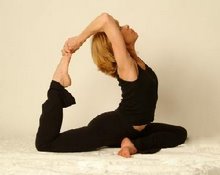I'm preparing to teach an 8-week Yoga History and Philosophy class I do every year for our Advanced Yoga Studies Program at Downtown Yoga in
Pleasanton.
I tend to start the "history" part a little further back each year.
The last glacial epoch started about 110,000 years ago and ended about 15,000 years ago.
If you believe the fossil record, then during this time it appears there were three (3) different species of "Man." Neanderthal, Cro-magnon and what we now call "Modern Man" - or Homo sapien sapien all show fossil remains which overlap at concurrent periods (40,000-50,000 years BCE)
Yes, they all existed at the same time! I think if you were able to transport yourself back in time, then you'd place your money on Neanderthal to be the survivor of the three. He certainly seemed more "robust", bigger jaw to chew food, that sort of thing.
But alas, the "Ogre" of the lineage - Neanderthal - dies out in Gibraltar around 24,000 years ago and Cro-magnon doesn't seem to go much farther than the caves of France where he painted stories on the cave walls and ceilings of great hunts.
So around 12,000 years ago the ice starts melting and we come out of the Pleistocene epoch and into the Holocene period - the age of man. We are the survivors of the lineage. The theory goes that just prior to all the ice melting completely over the Bering Sea - an industrious bunch of hunters and gatherers march into the Western Hemisphere. It's hard to image today, but much of North America was under a sheet of ice 2-miles thick. There's still some controversy as a new find in Monte Verde, Chile show carbon-dated remains of a village that dates to 14,500 b.c. How did those people get there before the ice melted?
Regardless - back in the "Old World" three major river valleys are formed from the flow of glacial melt. They are - The Nile in Egypt. The confluence of the Tigris & Euphrates in present day Iraq, and the Indus & Saraswati rivers in present day Pakistan.
The river of life. These river valleys were lush, and everything living went there. Fertile soil as a result of the river sediments were perfect for growing and early farming starts.
Since people didn't have to "run after" food anymore, groups of people start forming early settlements, cities. One of the earliest neolithic sites in the Indus River valley is Mehrgarh - which conservatively dates to 9,000 BCE. This site was recently discovered (1973) and is located just a few miles from the Pakistan city of Quetta - near the Bolan Pass into Afghanistan. It appears that Mehrgarh may be as old a Jericho.
Mehrgarh is the first and earliest city of what would become a the great Indus Valley Civilization (IVC) - which spanned several thousand years. Harappa is a city further north - near present day Lahore, Pakistan - becomes one of the larger cities of the IVC in 3,000 BCE.
The IVC left a script of sorts and "seals" - yet there is no "Rosetta Stone" to decipher the language. The IVC are not the ancestors of the present day people in the region. There is still debate over how the "Aryan" peoples populated the Indian Subcontinent. Yet, the IVC civilization does die out after quite a long run. However, they leave us an interesting clue as to when this practice of "YOGA" actually begins. A seal in a rock - an image - is it a man? a god? a beast of sorts. The seal is known as the "Pashupati Seal" - a lord of the animals. The seal seems to depict a person sitting in a yogic position - there is still some debate over this. The image has three faces - some speculate a "pro-shiva" - the first Shiva lord.
Soon after the IVC disappears - we get some poems, songs, stories - they are what we now know as the Rig Veda (2,000 BCE?) - the first and earliest Sanskrit scripts of a spiritual, religious nature. They tell of the "gods" - Indra , Agni, Vayu - and of the "long-hair' ascetic (yogi) who"... holds fire, holds the sky and reveals everything so everyone can see the sun, long-hair declares the light." This "long-hair" (Kesin) is described in verse - 10.135 of the Rig. He seems to be the pre-curser to the Upanishadic Yogi's.
From here we get quite an abundance of literature which tell us of the practice of Yoga - the practice of inquiry, the practice of meditation, the practice of selfless-service. The Vedas, the Upanishads, the Mahabharata, the Bhagavad-Gita all begin to "clarify" the practice - and the practice is one of meditation.
563 BCE - the Buddha is born and at 35 years of age decides to sit under a tree until he "gets it" - that's determination. Luckily for him and us, he discovers the middle-path and becomes enlightened. He teaches the Four Noble truths and the Eightfold Path for 45 years. Yes, the Buddha was a yogi.
More to come....








